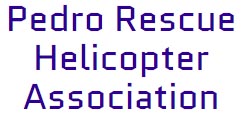Where it all Started
Preface
This overview is edited from stories and mission reports published in the Kaman Rotor Tips magazines and in newspapers, as well as from personal accounts by the men who flew with the H-43A. Some of the many documents available from the archive of the A.F. Historical Research Agency (AFHRA), Maxwell AFB, AL. were consulted during my visits to the Agency back in 1996 and 2001. – Johan D. Ragay, February 2019
In a letter, dated 17 May 2018, Mr.Jesse Munoz, Jr. (MSGT, USAF, Ret.) wrote the following :
“I finally put the package together. I have enclosed a photo-copy of the first AF Airborne Firemen, copy of Certificate of Completion which I received, newspaper photos of our H-43A Fire Training, newspaper clipping of an actual plane crash where we first used the FSK.
Nobody has this information and I thought perhaps you as our Historian (PRHA) should have it and long after I am gone you may present it to anyone asking about the origin of the Air Force Helicopter Firefighting and Rescue. I don’t think there is anybody better qualified than you to do this.”
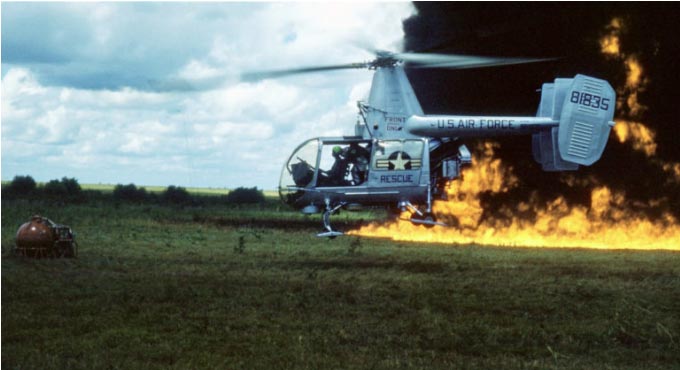
Mr. Carlton Damonte (Lt.Col. USAF Ret.) wrote :
“She certainly isn’t a legend, the H-43A. Most helicopter pilots today probably never heard of her. She didn’t even have a name. Today (ca.1995) , those of us who flew her 35 years ago still refer to the old bird simply as the “A” model. All were assigned to the Air Training Command to provide crash rescue support. Within two and a half years her career was over and she was shipped to the boneyard, replaced by her big sister the H-43B Huskie”.
1.0 Introduction – H-43A and Local Base Rescue
The U.S. Air Force H-43A helicopter, selected to fill the local crash-rescue mission, was developed by Kaman for operations in areas of mud, sand and snow.
The H-43A configuration differs from the HOK-1 , since 1956 the Marines version of this aircraft, primarily by replacement of the vertical center fin of the HOK-1 and HUK-1 (US Navy) with two dorsal and ventral fins attached to the booms. The elevator span had been extended by 2 feet on the H-43A, and the vertical fins attached to the ends of the elevator have been increased in size. The two center dorsal fins provide a marked improvement in directional stability, compared to the HOK, during power-on and -off approaches, especially during crosswind approaches. Bear-paw landing gear was added as well. (source : Limited Performance Evaluation of the H-43A, Report AFFTC-TN-59-4, dated March 1959)
Mission role for the H-43A with the USAF included standby air operation during mass airplane landings and take-offs, to locate and pinpoint any emergencies and accidents and bring back disabled crew members. Thousand-pound firefighting and rescue kit, including fire extinguishing agent, axes, bars, metal cutters, etc. can be suspended beneath the helicopter. (Aviation Week – February 23, 1959)
After reorganizations and reductions in strength that began shortly after the close of the Korean War, the need for an organized rescue service in the Air Force was again questioned in 1959.
As of February 1959 and up to 30 September 1961 the 18 H-43A aircraft made part of the major unit at the station of assignment.
But in 1961 the Air Rescue Service accomplished the necessary planning to assume both the National SAR Plan and the Local Base Rescue Helicopter Program.
Later , the LBR function were transferred from individual commands to the ARS. As of 01 October 1961 the CONAC RCC’s , all operating the H-43A, were organized as follows:
EASTERN ARC, Hq. at Robins AFB, GA :
| assigned – up to Sep61 | station | assigned – as/of Oct61 | H-43A from / to |
|---|---|---|---|
| 3505th PTW | Greenville AFB, MS | —— | Jun 59 – Oct 60 |
| 3550th PTW | Moody AFB, GA | DET.54 , EARC | Mar 59 – Feb 62 |
| 3615th PTW | Craig AFB, AL | DET.53 , EARC | May 59 – Dec 61 |
CENTRAL ARC, Hq. at Hensley NAS , Dallas, TX:
| assigned – up to Sep61 | station | assigned – as/of Oct61 | H-43A from / to |
|---|---|---|---|
| 3510th PTW | Randolph AFB, TX | DET.28 , CARC | May 59 – Jan 63 |
| 3555th PTW | Perrin AFB, TX | DET.33 , CARC | Mar 59 – Jul 62 |
| 3565th NATW | JamesConnally AFB, TX | DET.38 , CARC | Apr 59 – May 62 |
| 3575th PTW | Vance AFB, OK | DET.29 , CARC | Aug 59 – Dec 61 |
| 3640th PTW | Laredo AFB, TX | DET.36 , CARC | Jan 59 – Dec 61 |
WESTERN ARC, Hq. at Hamilton AFB, CA:
| assigned – up to Sep61 | station | assigned – as/of Oct61 | H-43A from / to |
|---|---|---|---|
| 3525th PTW | Williams AFB, AZ | DET.16 , WARC | Oct 60 – Jan 62 |
2.0 From production line to Air Force delivery
The only batch of H-43A ordered by the Air Force was for a total of 18 aircraft , serial numbers 58-1823 to 58-1840 (contract AF-36190).
The first H-43A coming from production line at Bloomfield, CT, was 58-1823 which made it’s maiden flight on 19 September 1958. It stayed with the manufacturer for trials up to September 1959. Vance AFB, OK became it’s first LBR assignment.
One extra H-43A, a 19th, with serial number AF 58-5524 was bought by the USAF and bailed to Kaman for evaluation in anticipation of the first production H-43A. Kaman used aircaft 58-5524 for various tests and called it in it’s reports “the demonstrator H-43A”.
This particular aircraft was former HOK BuerNo. 129839. It was struck of charge on 23 Jan 1957 (after an accident at Camp Pendleton, CA on 19 Sep 1956). Transferred to Bloomfield, CT and restored, but it did not return to the Marine Corps. As Kaman Model K-600 the aircraft then flew with FAA Registration number N298B in a grey and red scheme and with Kaman title. First seen in April 1958. It had the newly developed four-fin tail mounted. By June 1958 the aircraft was repainted in sliver finish with USAF title and serial number. This 58-5524 always remained at Bloomfield, CT and was used for many trials, up into early 1963.
Between 28 Nov 1958 and 17 July 1959 all 18 were accepted by the Air Force at the Bloomfield, CT plant.
The first two production H-43As delivered to the Air Force were accepted and ferried to Laredo AFB, TX (3640th PTW) by Captains Bert E. Cowden and Theodore C. Vurbeff . H-43A 58-1824 accepted on 31 Jan 1959, and 58-1825 accepted on 27 Feb 1959.
A1C Jesse Munoz Jr. was one of the first firemen assigned to the 3640th PTW, Laredo AFB, TX.
In 2018 Mr. Munoz provided the following details for this moment.
(Source : Article : “Ring of Fire” , “Fighting Fires with the H-43A” , by MSgt Jesse Munoz, Jr USAF Retired. Published in “ The RIP Chord” , McChord Field, WA – Volume 46, number 1 , Jan-Mar 2018)
Our story starts with a staff meeting for all Fire Department personnel at Laredo AFB, Texas in late February 1959. The Fire Chief informed us that our base was forming a new unit called H-43A Local Base Rescue Section from Air Rescue Service and involved training base firemen. They were asking for volunteers, I was a young Airman First Class. The thrill of flying got my immediate attention and I volunteered. There were eight of us and little did I know to what paths it would take me.
A few days later we were given an orientation flight on a H-19. Then they took us to see the H-43A. It looked awkward and looked much like an ugly eggbeater. We wondered if it could really fly. We started training in early March with a Kaman Aircraft Corporation Representative who taught us the capabilities of the H-43A and its FSK. Next, he gave us a briefing on the firefighting operations. We were also provided a booklet of operating instructions about our new “Toy” called the Fire Suppression Kit (FSK) and nicknamed the “Sputnik”. He showed us how the FSK worked, we completed our training March 31, 1959 and received our certificates from Kaman Aircraft Corp.
These eight men are the first group of firefighters in the U.S. Air Force to complete the 40 hour H-43A Helicopter firefighting course. Training was taken at the crash station and drill area at Leredo AFB, TX. Standing, left to right:
A/1C Leonard J. Bowker , TSgt Raymond Cerda, A/3C Dennis J. Witt, SSgt Tomas M. Garza, A/1C Roberto Rodriguez,
Squatting : A/3C James R. Eubanks, A/1C Jesus Munoz, and A/2C Robert M. Rohrer.
Not in the picture is A/2C Federico Arriaga.
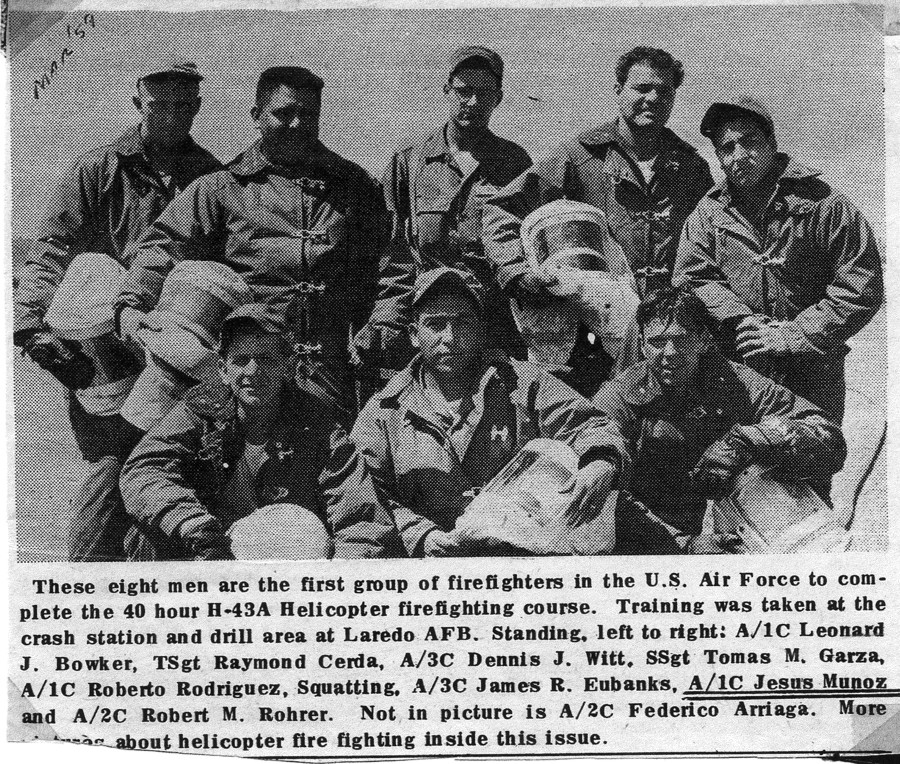
photo published in “Que Paso” newspaper xx March 1959
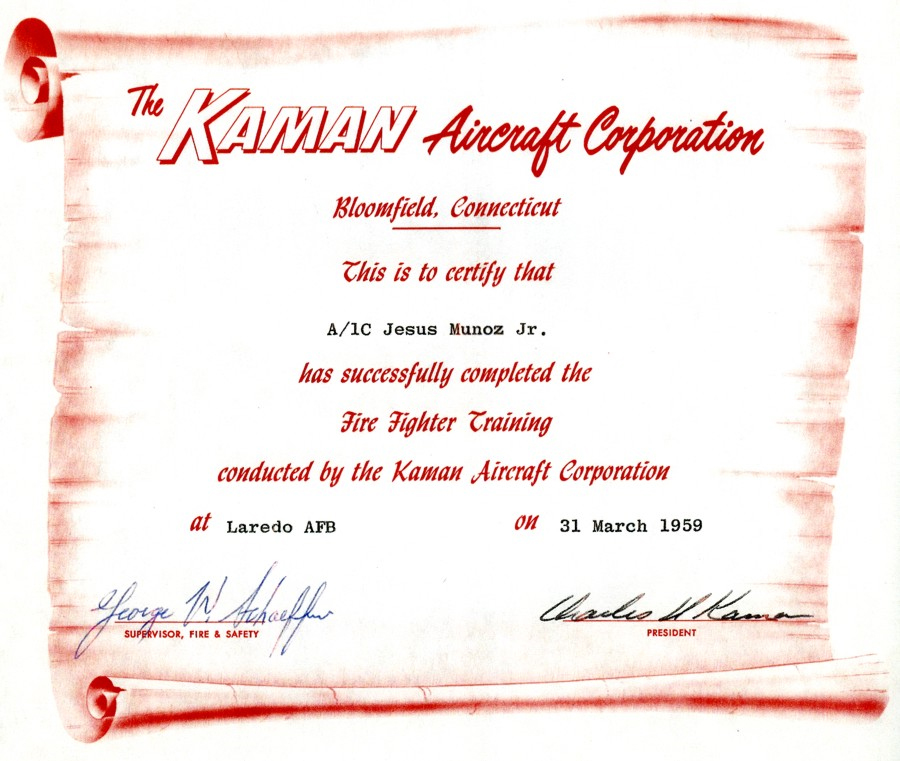
3.0 Available mission reports and other unit-related information
- 3.1 Laredo AFB, TX
- 3.2 Moody AFB, GA
- 3.3 Perrin AFB, TX
- 3.4 James Connally AFB, TX
- 3.5 Craig AFB, AL
- 3.6 Randolph AFB, TX
- 3.7 Greenville AFB, MS
- 3.8 Vance AFB, OK
- 3.9 Williams AFB, AZ
- 3.10 Known crew-members who have been assigned to H-43A units
3.1 Laredo AFB, TX – 3640th PTW – DET.36, CARC
H-43A 58-1824 was accepted at Kaman, Bloomfield, CT on 31 Jan 1959, and 58-1825 on 27 Feb 1959.
They were ferried to Laredo AFB, TX by Captains Bert E. Cowden and Theodore C. Vurbeff .
This was the first helicopter unit in the Air Force to become operational utilizing the H-43A and the Fire Suppression Kit. Working with the Air Training Command Standardization Team, this helicopter section helped establish the procedures later used by Local Base Rescue detachments throughout the Air Force.
3.1.1 “Good Vibrations ? “ by Jesse Munoz, Jr. (MSgt , USAF Retired)
(Source : Article : “Ring of Fire” , “Fighting Fires with the H-43A” , by MSgt Jesse Munoz, Jr USAF Retired. Published in “ The RIP Chord” , McChord Field, WA – Volume 46, number 1 , Jan-Mar 2018)
As for the flying part, the H-43A was noisy with the reciprocating engine right in the back of you, the fumes made you sick, it was rough and shaky and at times scary. We sat right behind the pilot, could see his every move and the instrument panel. It was very cramped and had little room to stretch, being a short guy I didn’t have as much trouble getting in or out as our bigger guys, especially with our bunker clothing. For one thing you got plenty of air and got to see everything below.
Laredo was hotter than hell; the temperature on the ramp got to about 120˚ or higher and on a few occasions the chopper didn’t have the power to get off the ground with the 1000 lb. FSK so we took off without it. Towards the end of the month when no one wanted to go fly anymore, I would volunteer to go fly around the flagpole. But the biggest flying thrill was when one of our pilots used to do 360’s from different altitudes, one right after another.
The first couple times I got sick, NO BULL!!!. My scariest flying experience was when we went on a night training flight (Pilot, Co-Pilot, a mechanic and me). The pilot was going to give this co-pilot training on “How to recover an out of control chopper”. Anyway, we flew out away from the base and it was pitch dark (not sure of the altitude). The pilot told the co-pilot to cover his eyes as he put the collective control down and put it out of configuration. We started dropping down fast!!! The co-pilot was attempting to get the chopper back in control and it kept on dropping and I started bracing myself as did the mechanic. The pilot took over the controls and it seemed like an eternity before he flared. When he turned on the floodlights, we were skimming the top of the mesquite trees maybe 10 or 12 feet from the ground. I thought for sure we were going to crash and maybe almost did. We flew in silence back to the base and nothing more was ever said. That memory persisted for couple of years and I had some bad nightmares. But the best part was when I rode in the co-pilots seat and one of our pilots would let me handle the controls, nothing fancy just left and right turns and up and down. This was a great thrill and I loved flying, I was lucky to get some “stick time”, I also got stick time on the B model there and at another base. When the “B” model came around, it was like a flying Cadillac and according to my Individual Flight Record, I logged my first flight in the Huskie in November of 1961.
I have very fond memories of the Laredo Bunch (Pilots, Mechanics & Firemen) that I met there. I keep in touch with a few of them: Pilots – Lt Col(s) Clyde “Red” Lemke, Donald Van Meter, John E. Shaeffer and fireman A2C Frank G. Gonzales who came on board in 1962.
3.1.2 April 1959
Article, published in “Que Paso” newspaper , dated Thursday 16 April 1959 , page 8
“H-43A Helicopter : Airborne Fire Station” (photos by 2nd Lt. Joshua Galindo)
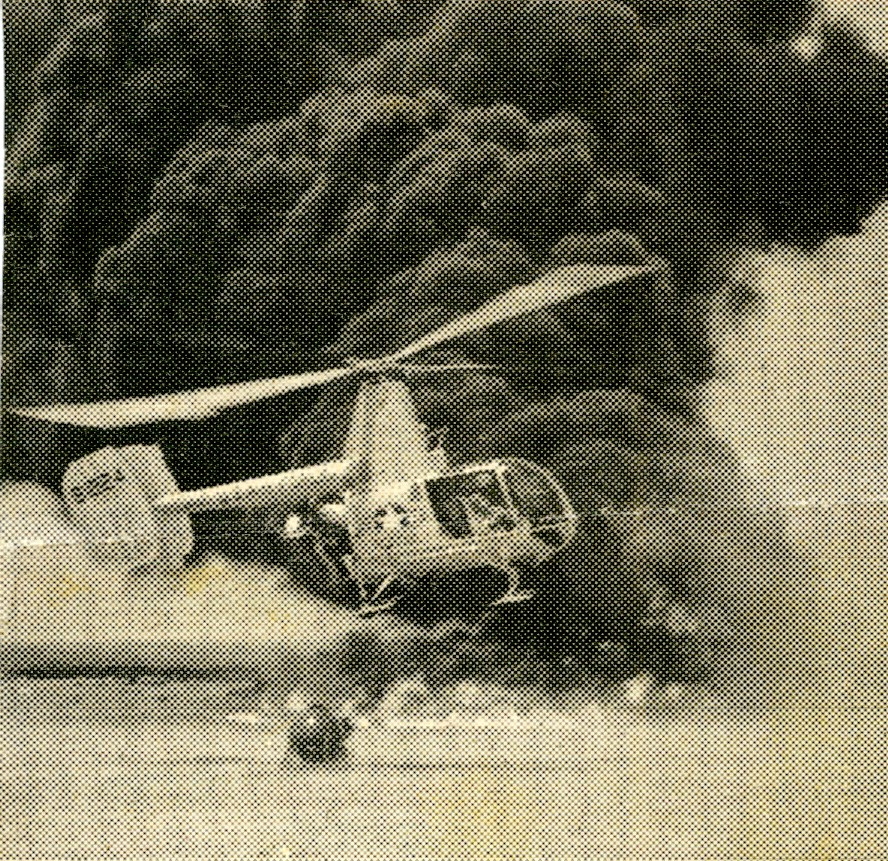
58-1824 3640th PTW , Laredo AFB, TX (“Que Paso” newspaper , 16 April 1959)
This sequence of shots taken at a recent demonstration by the base rescue helicopter, the Kaman H-43A illustrates the versatility of the new aircraft.
In First photo, “chopper” arrives at the scene carrying an airborne extinguisher and checks wind direction.
Photo 2, pilot drops equipment approximately 75 feet from “crash” scene.
Photo 3, crew has jumped out of helicopter and prepares extinguisher for action.
Photo 4, nozzle man approaches fire and builds foam bank as “chopper” hovers and blows foam over fire.
Photo 5, the fire is under control and rescue has been accomplished.
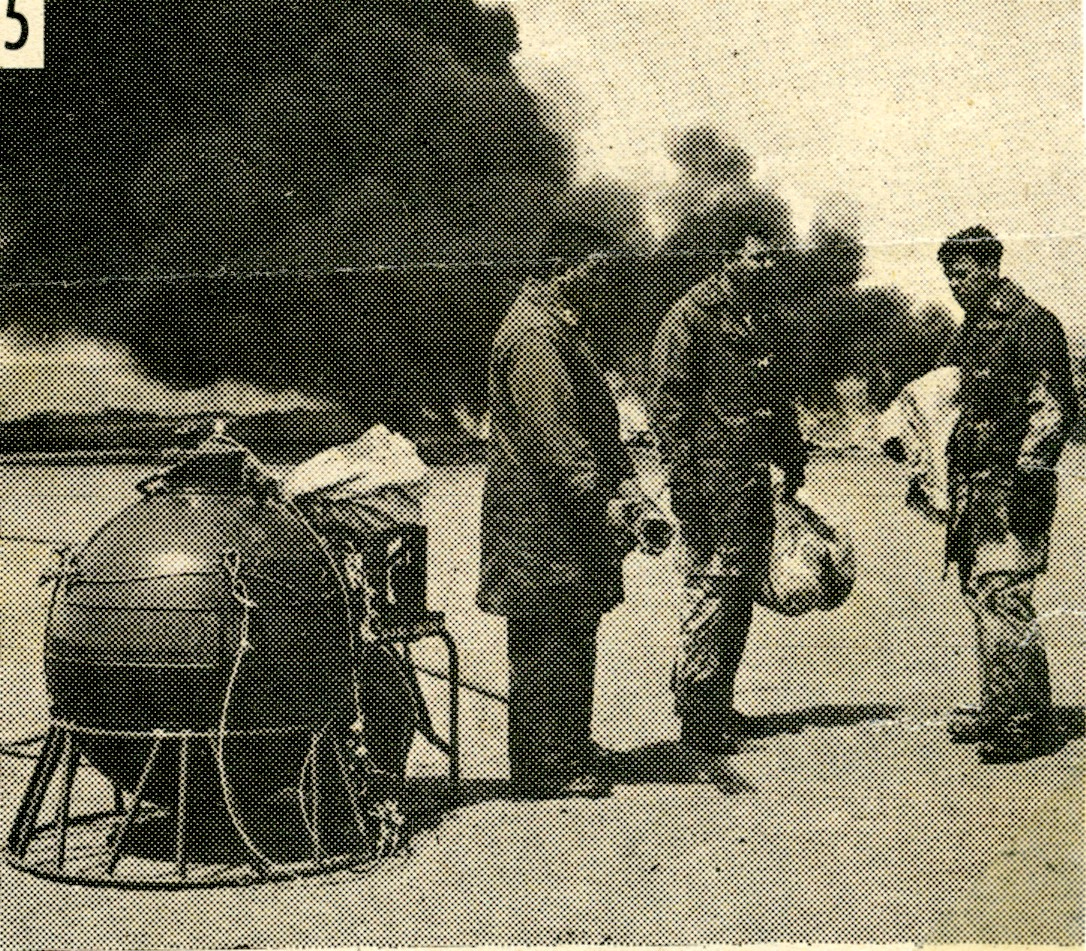
no.5 – left to right: TSgt Raymond Cerda, SSgt Tomas Garza and A/2C Robert Rohrer.
Protective clothing and crash hoods, shield rescuers from intense heat while removing pilot or passengers from aircraft.
Helicopter will return to pick up crew and equipment after first flying “victim” to base for medical aid. Time elapsed for rescue operation is 60 seconds.
3.1.3 July 1959
Article, published in ?? newspaper , dated 09 July 1959
H-43A Proves its Capabilities – Fighting Fire At Crash Scene
An Laredo AFB helicopter crew proved the capabilities of the H-43A helicopter last week after the fatal crash of a T-33A.
Just 48 seconds after the crash signal, the helicopter with fire fighting equipment was airborne and on its way to the crash scene. Arriving at the scene, Lt Bert Cowden, pilot of the H-43A, placed the fire fighting kit and crew in position and went to work suppressing the flames with the rotor wash from the chopper.
Because of the wide spread area of the fire and a malfunction in the fire fighting kit, Cowden had to fly within the perimeter of the flames to direct the rotor wash on the cockpit of the crashed aircraft. The heat was so intense that Cowden received minor burns about the face.
On the ground A/1C Jesus Munoz and A/2C Johnny Hinson, both firemen, went into the fire area with only rotor wash protection and ascertained that no one was in the cockpit.
Lt Cowden continued to literally fight the fire with the H-43A and succeeded in extinguishing the flames by using only the rotor wash from the helicopter.
Lt John Shaffer, Officer in Charge of helicopter section, had high praise for Lt Cowden and his crew. “Indeed these men demonstrated great courage in their crash-rescue mission. It is regrettable that there was nothing we could do to save the life of the pilot who had ejected.”
3.1.3 July 1959
Article, published in ?? newspaper , dated 09 July 1959
H-43A Proves its Capabilities – Fighting Fire At Crash Scene
An Laredo AFB helicopter crew proved the capabilities of the H-43A helicopter last week after the fatal crash of a T-33A.
Just 48 seconds after the crash signal, the helicopter with fire fighting equipment was airborne and on its way to the crash scene. Arriving at the scene, Lt Bert Cowden, pilot of the H-43A, placed the fire fighting kit and crew in position and went to work suppressing the flames with the rotor wash from the chopper.
Because of the wide spread area of the fire and a malfunction in the fire fighting kit, Cowden had to fly within the perimeter of the flames to direct the rotor wash on the cockpit of the crashed aircraft. The heat was so intense that Cowden received minor burns about the face.
On the ground A/1C Jesus Munoz and A/2C Johnny Hinson, both firemen, went into the fire area with only rotor wash protection and ascertained that no one was in the cockpit.
Lt Cowden continued to literally fight the fire with the H-43A and succeeded in extinguishing the flames by using only the rotor wash from the helicopter.
Lt John Shaffer, Officer in Charge of helicopter section, had high praise for Lt Cowden and his crew. “Indeed these men demonstrated great courage in their crash-rescue mission. It is regrettable that there was nothing we could do to save the life of the pilot who had ejected.”
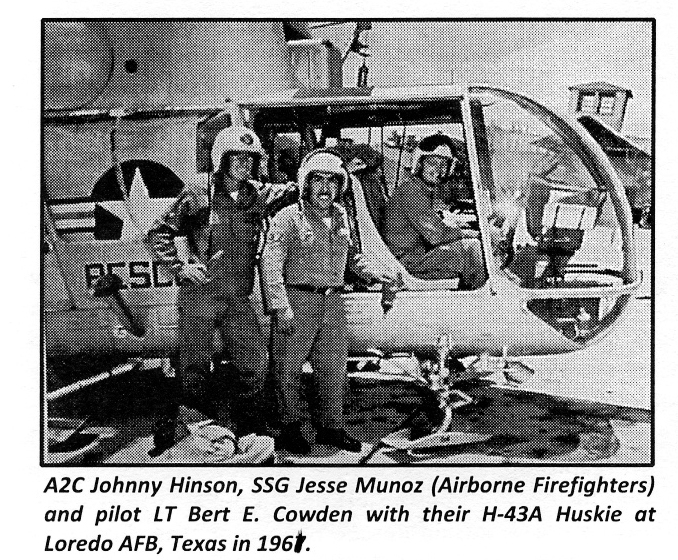
3.1.4 Article, published in “Que Paso” newspaper , dated Friday 17 August 1962
CARC Det. 36 claims unique operation record of accomplishment with the H-43A helicopter in carrying out their air rescue mission. The detachment has compiled a formidable record of firsts during the past three years.
3.1.4.1 Capt. Bert E. Cowden and Capt. Theodore C. Vurbeff accepted and delivered the first two H-43A helicopters from the Kaman Aircraft Corp. to Laredo AFB. Working with the other members of the detachment and the Air Training Command Standardization Team, the two helicopter pilots worked out rescue procedures, utilizing the fire-suppression kit, now used by rescue detachments throughout the Air Force.
3.1.4.2 Capt. Cowden was the first USAF pilot to use the H-43A rotor down-wash for fire suppression during an actual crash on 09 July 1959. He was first to use the down-wash in conjunction with the fire suppression kit on 25 September of the same year.
3.1.4.3 On 15 Feb 1960, Captains Cowden and John C. Shaeffer played leading roles in a dramatic rescue operation when 20 fishermen were stranded on the south shore of Lake Falcon by a violent wind and rain storm. The two pilots flew eight separate sorties, all in marginal wind and visibility conditions, and brought all the stranded sportsmen to safety.
They were the first USAF pilots to receive the Kaman Scroll of Honor as a result of this mission.
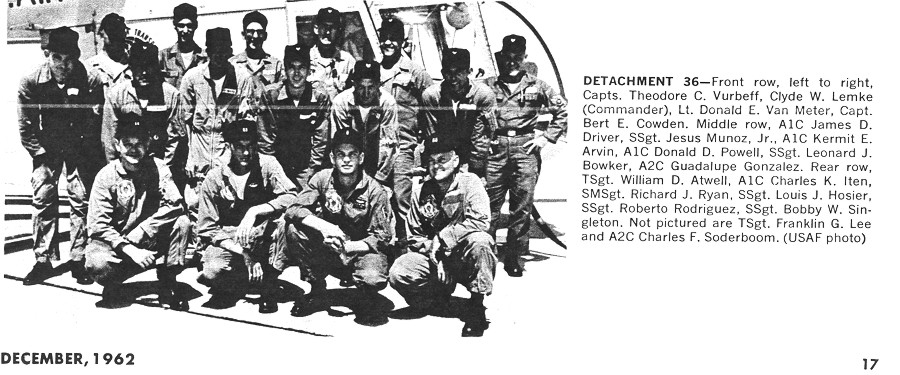
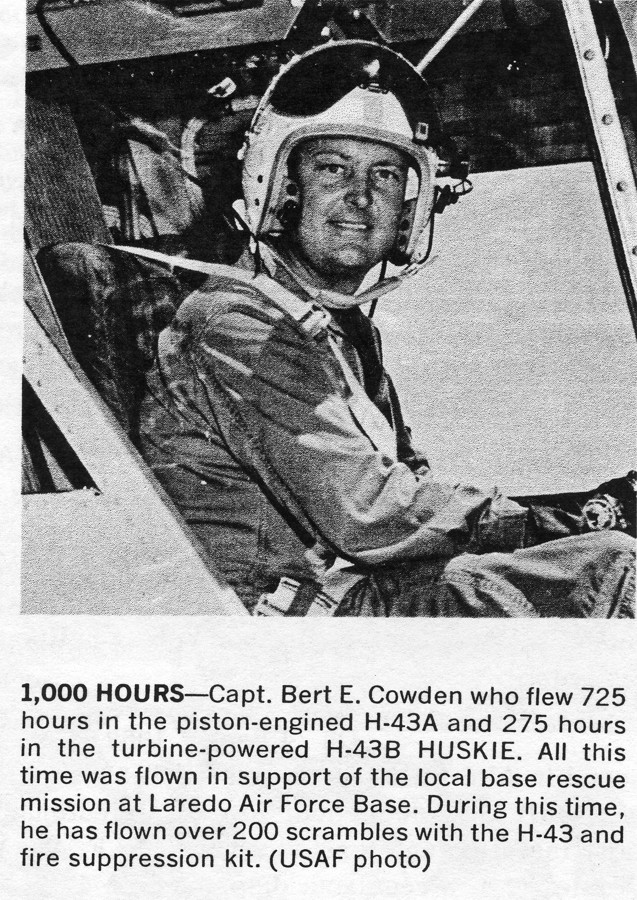
3.1.5 Capt Bert E. Cowden, the first military pilot to log 1000 hours in a helicopter produced by Kaman Aircraft, flew 725 hours in the H-43A (source : Kaman Rotor Tips, issue Dec62 , page17 )
3.1.6 Capt. Clyde W. “Red” Lemke, who wrote in an email, dated 13 Jan 2007 :
“I began my introduction to the H-43A at Laredo in January of 1960. I was fortunate enough to receive my training locally with the pilots that picked up the first two aircraft for the Air Force. That was Lt Bert Cowden and Lt Ted Verbeff, who in turn pretty much developed the Air Force firefighting procedures.
3.1.7 Retirement H-43A
H-43A 58-1824 and 58-1825 were placed in storage at Davis-Monthan AFB as they became excess to command requirements. Both arrived at the boneyard during December 1961.
(source : AFHRA doc – file K318.2 Jul-Dec 61, VOL.III Annex I )
3.1.8 New Aircraft
Two H-43B aircraft for DET.36, CARC were accepted by USAF at Kaman Aircraft Corp. and were airlifted to Laredo AFB, TX. They were 60-0277 (23 Oct 1961) and 60-0278 (28 Oct 1961).
(source : AFHRA doc – “Minutes of Staff Meeting, 27 Oct 61 ; file K318.2 Jul-Dec 61, VOL.III Annex I )
3.2 Moody AFB, GA – 3550th PTW – DET.54, EARC
H-43A 58-1826 was accepted on 04 Mar 1959 and 58-1827 on 31 Mar 1959.
3.2.1 Personal account by Richard H. Smith , date ?? (taken from a guestbook page)
My first flight in the H-43A was on March 19, 1959 at the Kaman factory in Bloomfield, CT.
I was sent there from Moody AFB in GA to check out and take delivery of the third H-43 delivered to the AF. My boss, Capt. Clayton Nirmeier preceded me to the factory and brought one of the first two H-43A’s back to Moody.
By Sep 1961, when I left Moody for assignment to the RCC at Elmendorf AFB, AK , I had been the primary instructor for the likes of Clyde Ashton, Dave Pittard, Grant Kerber and later Grant Mackie.
In 1965 I checked out in the H-43B at Loring AFB.
By the way, for the old Kaman guys, Frank Horn was my instructor at the factory and Bob Lambert came to Moody a few times as Tech.Rep.
3.2.2 B-52 emergency landing at Turner AFB, GA , 18 October 1961
( source : AFHRA doc. – Hq ARS “Command Monthly Letter”, 31 Oct 61 ; file K318.2 Jul-Dec 61, VOL.III Annex I )
The importance of having a versatile helicopter with flexibility in aerospace operation was recently demonstrated in a night precautionary SAR mission at Turner AFB, GA.
A SAC B-52 was experiencing hydraulic and power system difficulties, and a gear-up landing was a possibility if helicopter coverage with fire-suppression capability was available. Eastern ARC coordinated this mission and dispatched a H-43B helicopter with fire-suppression kit and a H-43A helicopter with fire fighting personnel from Moody AFB, GA. The success of this mission can best be described by quoting the following message from the Commander, 4138 Strategic Wing, Turner AFB :
“The two helicopter crews who responded to the B-52 emergency at Turner AFB are commended for their professional performance. The crews became airborne immediately upon request, arrived at Turner in a minimum period of time, went on alert standby, and became airborne again to meet the landing emergency. During the landing the helicopters flew close formation with the B-52, affording maximum fire protection coverage and rescue capability. Through their actions they received highly favorable comments from the B-52 crew and members of my staff. Request you pass on my sincere appreciation to Major Gordon S. Priest, Duty Coordinator, EARC, Robins AFB, GA, for his efficient assistance and to the helicopter crews for their outstanding performance of duty.”
Report from:
“A chronological listing of rescue reports as received from the field by the Kaman Aircraft Corporation”
18 October 1961 TURNER AIR FORCE BASE
The Strategic Air Command, Command Post at Robins AFB alerted Eastern Air Rescue Center at 0045 EST on 18 October 1961 stating that there was an airborne B-52 experiencing hydraulic, mechanical, and power system difficulty which indicated a gear up landing was imminent.
The decision was made at EARC to Launch the H-43’s from Moody and the SAC Commander made the decision to attempt the B-52 landing at Turner (home base of the B-52) , providing the H-43 helicopter with the fire suppression kit could be made available. At 0100 EST, Eastern Air Rescue Center notified Moody to dispatch their H-43 helicopters to Turner. At 0230 EST the H-43A and B had completed the 70 nautical mile flight and were in position at Turner with the H-43B carrying the fire suppression kit and the H-43A carrying fire fighting personnel.
The B-52 made a successful gear down landing at 0406 EST and for the distance for the roll-out on landing the H-43’s flew one on each side of the B-52 until it came to a stop at the end of the runway. The B-52 made a successful landing and the six crew members were extremely grateful to the service that ARS provided them for the emergency. The SAC Wing Commander at Turner advised Colonel Dunkleburg, EARC Commander that he was writing a very laudatory commendation letter to General Tom Power which he in turn is requesting be passed on to General Joe Kelly of MATS citing a job well done on the part of the personnel of EARC and LBR Detachment 54 from Moody.
Reading from the ARS Mission Report, …… At 0445 EST aircraft and crews released to return to Moody, further indicating the flexibility and need of the versatile helicopter in aerospace operation. This constitutes final mission report.”
Report from Rotor Tips:
ARS DET. 54 at Moody AFB, GA , scrambles two helicopters, an H-43B with FSK and an H-43A as back up, flys 66 miles to Turner AFB after B-52 declares an emergency due to hydraulic system malfunction. Bomber escorted down runway by both helicopters, “B” drops Fire Suppression Kit and firemen by nose of giant ship as precautionary measure after it safely comes to halt. Firemen ordered to foam aircraft down at first sign of spark. As crew of B-52 evacuate, they are greeted by down-wash from rotors of both H-43s which have assumed positions to cool overheated brakes and wheels on B-52.
H-43B crew : Capt. William J. Fitzgerald, pilot; Capt. Grant F. Mackie, co-pilot; SSgt. Arlie P. Stalvey and Alc S. Jarrell, firemen.
H-43A crew : 1st Lt. David H. Pittard, pilot; lst Lt. Grant D. Kerber, co-pilot; SSgt. Frank D. Hinton, Alc Sidney Allen, firemen; TSgt. Joseph Blaquiere, crew chief.
(source : Kaman Rotor Tips , issue February 1962 , page 16)
3.2.3 Known crew-members who have been assigned to this H-43A unit
3.2.3.1 Maj Richard A. Smith receives congratulations from Capt Oliver E. Schmoker after logging his 2000th hour in the HH-43 HUSKIE. Major Smith, commander of Det 16, CARRC, McConnell AFB, Kan., went over the 2000-hour mark while on an emergency scramble. The Major has been flying the HH-43 since July 1960 and is one of the few pilots who logged time in all three HUSKIE models–the H-43A, HH-43B and the HH-43F.
(source : Kaman RotorTips, issue Jan-Feb69 , page 23)
3.2.3.2 Grant F. Mackie (source : guestbook entry, Crash Rescue – Air Rescue Web Site – Bill Junkins)
I was a pilot and Detachment Comdr. at Moody AFB 1959 to 1963 flying H-43A (ATC) and then later B models. We had a great group of firefighters who were dedicated to the program with S/Sgt Arlie P. Stalvey as the NCOIC. Also an A1C Norton and others whose names I have forgotten.
3.2.4 Retirement H-43A
Both H-43A 58-1826 and 58-1827 were delivered to MASDC, Davis-Monthan AFB, AZ on 20 Feb 1962.
3.2.5 New Aircraft
Two H-43B aircraft were both delivered to DET.54, EARC from assignment at Robins AFB, GA on 01 Oct 1961 : 59-1568 and 59-1570
3.3 Perrin AFB, TX – 3555th PTW – DET.33, CARC
H-43A 58-1828 was accepted at Kaman, Bloomfield, CT on 24 Mar 1959 and 58-1829 on 08 Apr 1959
3.3.1 History of Flight, 58-1829 at Bloomfield, CT – 16 April 1959 (source : USAF Accident Report)
The flight took off from the Kaman Aircraft Company airport, Bloomfield, CT at 1100 EST, on 16 Apr 1959. The pilot, 1st Lt. James F. Okonek, was taking a factory transition course in the H-43A aircraft. He had completed 12 hours of the course prior to the flight. This flight was one hour in duration, giving the pilot a total of 13 hours in the H-43A at the time of the accident.
Various maneuvers were practiced during the flight, including three successful landings. After take-off from the third landing, at an altitude of approximately 300 feet, with an indicated airspeed of approximately 45 knots, a simulated engine failure after take-off, with practice auto-rotation landing, was started. The nose of the aircraft was lowered to increase the airspeed to 55-60 knots.
While successful auto-rotation landings can be made in the H-43A at lower airspeeds, no special emphasis on using a lower speed had been made during the course.
After assuming the nose down attitude, the pilot became aware of a much higher sink rate than was desired. He applied power to stop the descent and initiated a flare. During the flare he assumed a nose high attitude and the aircraft touched down on the rear wheels and tail fins.
3.3.2 Helicopter rescued person from Lake Texoma – 1960
(source : Newspaper clipping, unknown name/date , sometime 1960 – collection Tom Brumfield)
SHERMAN, TX – A Perrin AFB helicopter plucked one Sherman youth from Lake Texoma and three others were picked up by boats Friday morning after their boat overturned.
US Engineer Joe Wilson said the four left Highport Resort and were going around Preston Point to fish. Wison said the motor fell into the water, but still was fastened to the boat by a chain. When they tried to pull the motor from the water the boat capsized.
Staff Sgt George A. Payne, a Perrin Fireman, jumped into the water. Pilot of the Perrin helicopter was Capt James Okonek. Also on board was A1C Kenneth Parschal.
3.3.3 Helicopter Team Plucks man From Tree Top – 1960
(source : Newspaper clipping, unknown name/date , 1960 (possibly May 1960) – collection Tom Brumfield)
Perrin’s helicopter rescue team was pressed into service last Sunday to pick a man from a tree-top. A flash flood near Broken Bow, OK, drove Mr. Jack Dean to the top of the tree from fast rising waters.
Spectators had attempted to rescue Dean, but due to rushing water and debris had been unable to get near him. When the call came from the Oklahoma Highway Department at 4:25 pm, Dean had been in the tree 7 hours.
Capt Robert F. Bennett piloting the helicopter, was assisted in the rescue by A1C Kenneth Parscal and A1C George A. Payne. Bennett hovered near the tree top while Payne and Parscal demonstrated the correct way to “don” the hoist. Then the man was lifted into the helicopter and taken to Broken Bow.
Perrin maintains constant vigil with law enforcement officers of Texas and Oklahoma for rescue work. When students are flying, the helicopter stays in the air. On weekends, or when there is no flying, designated helicopter people are on 30-minute stand.
3.3.4 “Citation for a H-43A Pilot”
PERRIN AFB, TEX. — 1st Lt. Tom W. Brumfield, Jr., attached to the Helicopter Section here, has been awarded a Citation for Outstanding Airmanship in recognition of the professional skill he showed when an F-102A crashed short of the runway. The aircraft was coming in at night for an emergency landing.
Lieutenant Brumfield took off in a H-43A with a crash rescue team and fire suppression kit when the emergency was declared. He intended to hover at the approach end of the runway, but saw the F-102 crash and burst into flames about a quarter of a mile away. Lieutenant Brumfield flew immediately to the scene, made his approach and let out the team which had the kit in operation within 90 seconds from the time the plane crashed and came to rest.
The lieutenant’s citation said that, even though the F-102A pilot could not be saved, the aircraft exploded upon impact, “it in no way detracts from the professional skill exhibited by Lieutenant Brumfield.”
(source : Kaman RotorTips , issue October 1961 , page 8 )
(The F-102A involved was 56-1049 of 3555th PTW , crash date 12 Apr 1961)
3.3.5 Rescue mission 30 Nov 1961 “Copter Waits as Flier Takes Lake Dip”
DENISON, TX – It wasn’t an ideal day for a dip in Lake Texoma, but 2nd Lt. Henry M. Crook Jr., wound up in the Little Mineral Arm of the lake after he bailed out from his crippled F-102A Jet Thursday.
(add by Ragay : 30 Nov 1961 – F-102A 56-1075 – 3555th PTW)
And it was a fortunate coincidence for Lieutenant Crook that the rescue helicopter at Perrin AFB was on an orientation cruise in the vicinity at the time. The ‘copter crew got word from base operations that the flyer was leaving his plane and was at the water, some 200 yards from shore and nine miles north of the base. Lieutenant Crook had half his Mae West life preserver inflated by the time a line was dropped to the pilot from the helicopter. The flyer was dragged to shore and then Lt. Col. Reynold C. Craddock, new wing operations officer, and Sgt. Ray E. Owen, leaped into the shallow water and pulled the frigid flier aboard the helicopter. He was taken to the base hospital suffering from exposure and a slight cut on his head. The abandoned jet crashed near Walter Nitz home, north of Pottsboro.
(source : Newspaper clipping – collection Tom Brumfield)
3.3.6 “When Seconds Count!” (source : Kaman RotorTips , issue Feb 1962 pages 3-6,18 )
From Office of Information Perrin Air Force Base, Texas.
Ingenuity, resourcefulness and job “know-how” – all have been combined by the helicopter men at Perrin Air Force Base, Texas, in devising means of saving those precious seconds which could mean life or death to a rescuee.
Under the leadership of Major John A. Price, OIC, of the Helicopter Section, personnel have been encouraged to devise ways of stowing gear most efficiently in the unit’s H-43As and to develop additional equipment to improve their rescue capabilities. The major also contributed many ideas and suggestions and worked with his personnel on several of the projects.
Saving time through preparedness in advance has been the keynote of Major Price’s program and under his supervision crews practiced all emergency procedures over and over again to keep in top form and to insure that their actions under every foreseeable rescue condition would be “learned responses” that , come automatically.
“Under the conditions of an actual crash there is a tendency on the part of everyone to be in too much of a hurry and the result is that often ordinary precautions are sometimes forgotten,” Major Price said. This constant practice gives the rescue-men confidence and assurance that they can handle any situation and such practice also makes their response to an emergency quick, yet sure, the major added.
At least once a week for the last three years the helicopter rescue crews at Perrin have practiced their procedures by working with a “hot” fire around a dummy fuselage built from old tail pipes and-angle iron. In this type drill they use a dummy as the pilot to be rescued.
When the first H-43A arrived at Perrin and was put into service about three years ago, all of the needed gear and equipment was dumped helter-skelter on top of the litters. But as time passed, different crew members devised ingenious pockets on the back of the pilots’ seats and other belts with snap fasteners attached to the ceiling in which various tools, ladder, flares, etc. fit snugly. Crew members also figured out a way to install the litters so that one is set up at all times and still does not interfere with working through the open door. The second litter can be set up quickly.
“A place for everything and everything in its place,” has been the by-word of the alert crew.
The first aid kit which was carried in the type helicopter used prior to the H-43A proved to be much too large for the compact interior of the latter aircraft. Major Price gave the Flight Surgeon’s office at Perrin AFB the task of producing a smaller kit that would include all necessary elements.
The revised medical crash kit was adopted throughout the Air Training Command for use in the H-43A helicopters. It is small, compact and only weighs approximately 35 pounds.
A 25-watt transistorized amplifier has been installed on each helicopter which permits the pilot to talk to people on the ground. It is connected to the interphone system and can be keyed by the pilot’s microphone switch. It promises to be most useful in disaster control and water rescues or any time it is necessary to communicate with people outside of the aircraft.
An URC -4 is also carried and in case the crash rescue technician must go into a wooded area, he can maintain contact with the helicopter.
In connection with the use of the Fire Suppression Kit the alert crewmen devised a better system for storing the fire hose. Previously the 150 feet of nylon hose was folded in a rack attached to the unit and it was necessary for the entire length to be stretched out before the foam could be forced through. By using a reel to roll the first half of the hose they cut the time in half for putting the FSK into action. Where it used to take 30 seconds it now takes 15 seconds – in fighting a fire, every extra second counts !
Another time-saver developed at Perrin is that crash helmets, fitted with earphones, are installed inside the firemen’s asbestos hoods making it possible for the entire crew to hear all necessary details simultaneously.
And the pilot can communicate with the technicians via the inter-phone system.
Perrin helicopter crewmen worked diligently to provide a place for the numerous pieces of essential rescue equipment so that they were out of the way but readily accessible. Here is the location of rescue gear: 1. Disarming tool – behind pilot’s seat. 2. Pyrotechnic guns, 3 flares, 3 signal cartridges, and 3 message delivery containers – rack for original first aid kit. 3. Rescue screwdrivers, keyhole saw spare blades and gear, seat pins for a/c – carried in bag mounted on inspection door, left side (a belt has been fabricated to hold the other crash entry items). 4. Twenty-five feet of 1/2-inch nylon rope – carried on right inspection door. 5. Two MK-5 drift night signals – in the rear, far left and far right corners of aircraft. 6. Splint kit – back of center passenger seat. 7. Sling – back of center passenger seat. 8. Hoist operator’s retaining harness (gunner’s belt) – left and rear of overhead circuit breaker panel. 9. First aid kit – attendant’s seat. 10. Body bag – under attendant’s seat. 11. One-man life raft – left hand outboard passenger seat. 12. Two Mae Wests – above center passenger seat. 13. Aldis Lamp – right rear corner of floor board in front of pilot seat. 14. Flashlight – on bicycle clip in left rear corner of floorboard in front of pilot seat.
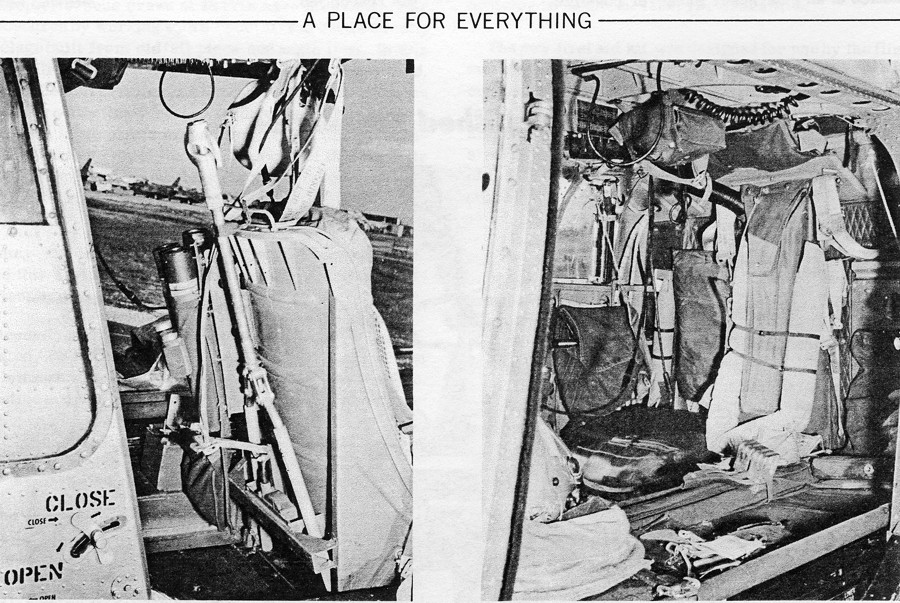
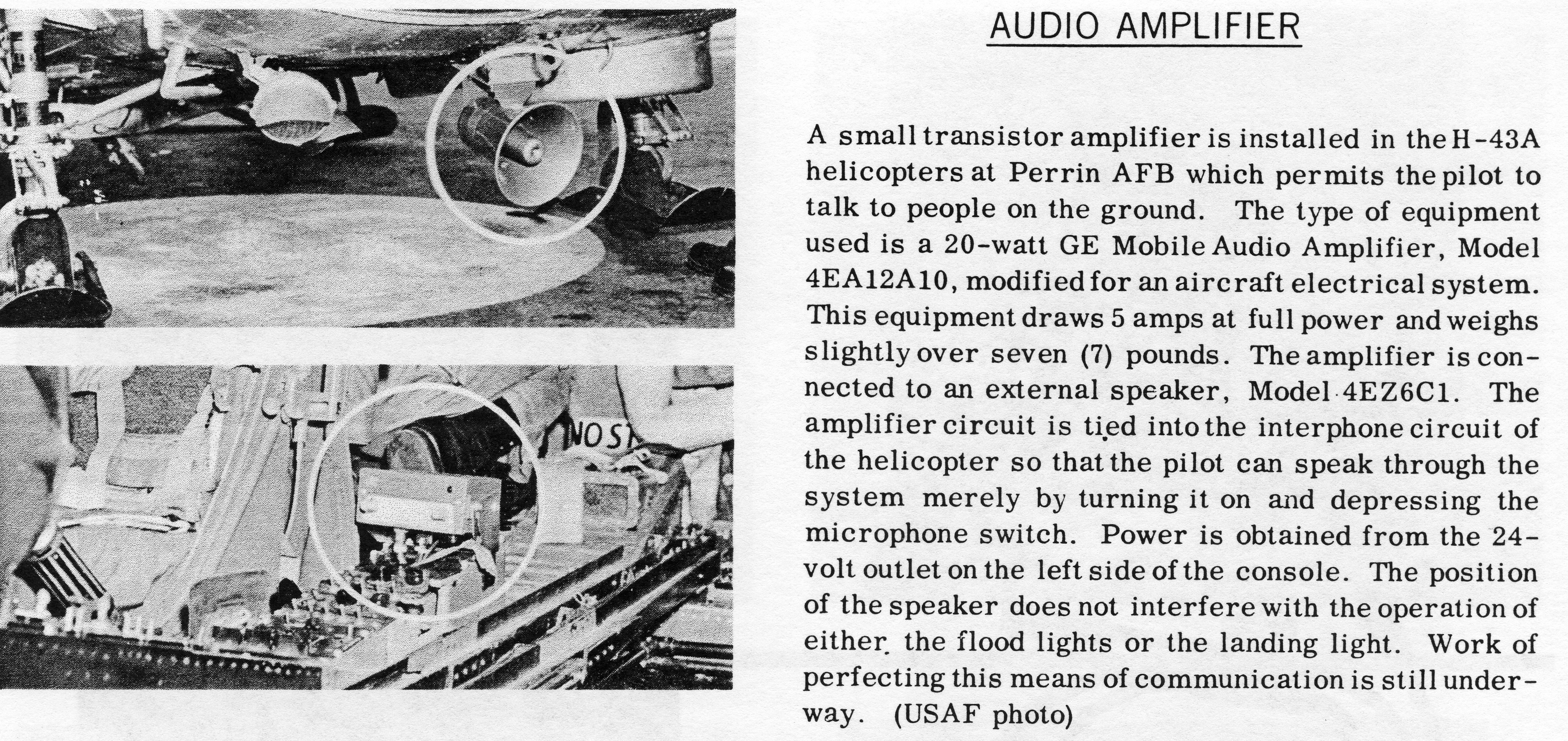
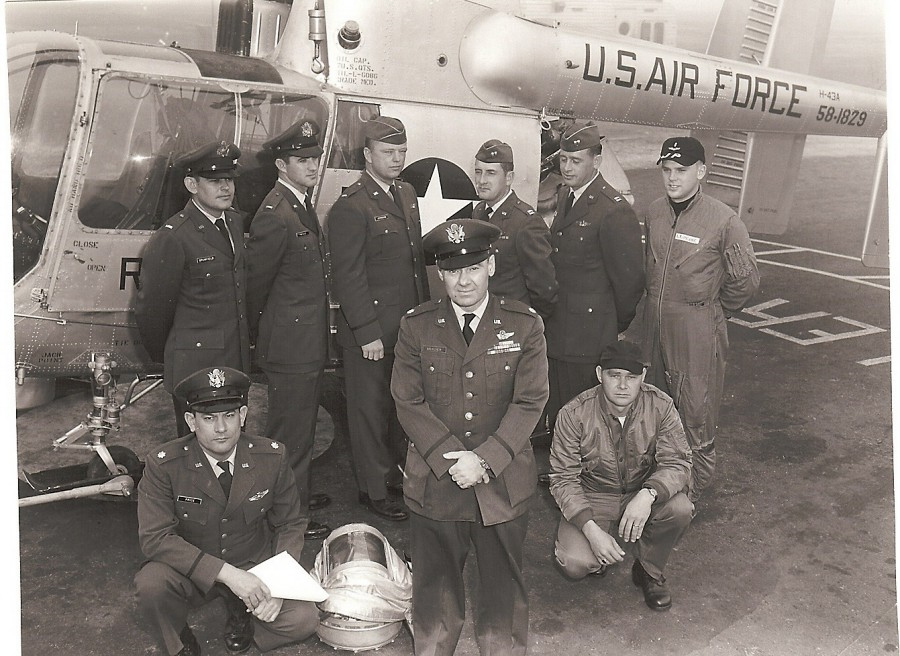
Photo taken at Perrin AFB, 1960-61 , collection Tom Brumfield (received from Jim Moore)
Standing L>R: Lt. Tom Brumfield, Lt. Ernie Neville, Lt. Johnson, Capt. Jim Okonek, Capt. Robert Bennett, Lt. Pease ; Front row: Major John Price, Major Paul Mercier, TSgt. Morphew
3.3.7 Retirement H-43A
H-43A 58-1828 and 58-1829 both arrived at the boneyard, Davis-Monthan AFB, AZ on 31 Jul 1962.
3.3.8 New Aircraft
Two H-43B aircraft were airlifted from Kaman to Perrin AFB, TX DET.33, CARC : 60-0281 and 60-0282 both on 05 Dec 1961.
3.4 James Connally AFB, TX – 3565th NA(navigational) TW – DET.38, CARC
H-43A 58-1830 and 58-1831 were both accepted at Kaman, Bloomfield, CT on 08 Apr 1959.
Aircraft 58-1831, which was ferried to base on 06 May 1959, crashed on 16 May 1959. It was replaced by 58-1838 on 20 Jul 1959. A third H-43A was re-assigned from Randolph AFB on 01 Sep 1961 (58-1837).
3.4.1 H-43A crashed 16 May 1959
“Helicopter Crashes At Air Show Here” (unknown newspaper – possibly Waco …… )
A helicopter crash at 3:06 pm Saturday caused a slight change in the hugh Share in America Armed Forces Day program at James Connally AFB , witnessed by an estimated 30,000 persons.
The fire-fighting demonstration officially tabbed for 3:45 pm began at 3:06 pm.
As a result the always exciting fire fighting show packed about as hard a wallop as the helicopter, which hit the runway and burst into flames as it skidded approximately 500 yards.
Only persons hurt were five spectators who were hit by flying splinters. They all were treated and released at the base hospital.
Lt. James C. Greenway III and his crew chief, SSgt Jimmy R. Haddox, who had brought their new H-43A from Connecticut only 10 days ago, climbed out of their blazing ship and ran to safety.
Approximately 15,000 were on the base at the time of the crash. Two of the H-43As just had finished a synchronized flying exhibition. This type of ‘copter is noted for its high maneuverability.
Then the team effort broke up. One of the H-43As made a fly-by to demonstrate speed. The other went up to a height estimated at from 700 to 2,000 feet.
Ey witness reports on what happened differ as much as the difference in height estimates.
Anyway, Lt. Greenway and his chief planned to demonstrated the stopping powers of their craft. They came down at about a 30-degree angle and were supposed to change the pitch of the props, immediately hovering instead of descending. An official investigation has not revealed what went wrong.
Anyway there was hovering to it. The ‘copter hit the runway, loosing both propellers, its wheels and other smaller pieces. It bounced, slipped on its side and started its long skid along the runway. It caught fire during the skid. Both men hooped out as soon as it stopped and ran toward the crowd. The ambulance quickly went to the scene “just in case “ .
So did the fire fighters, not “just in case” , and they had the fire out in – as one person put it – “a jiffy” .
Everyone agreed the fire show was far more exciting than it would have been had those drums of old oil been set afire at 3:45 pm.
3.4.2 “H-43A Pilot Saves Two “ (source : KamanRotorTips – issue October 1961, page 15)
CONNALLY AFB, TEX. — The F-89 was preparing to land when there was an explosion in the right engine and flames, four times as large as the aircraft, blossomed forth. The pilot, lst Lt. Clyde Falls, successfully completed his landing despite the fire.
Meanwhile, a H-43A being flown by lst Lt. Glyneth M. Gordon on a night transition flight, had been alerted to the emergency and followed the F-89 down the runway. As the F-89 came to a stop, Lieutenant Gordon used the helicopter rotor down-wash to blow the flames away from the cockpit and enabled the F-89 radar observer, 2nd Lt. Jay A. Johnson, to evacuate the aircraft without incident. Lieutenant Falls, however, was delayed when his personal equipment caught in the cockpit. During the brief delay, the H-43A down-wash kept flames away from Lieutenant Falls until he also evacuated.
And ( source : KamanRotorTips – issue April 1962, page 18 )
A Scroll of Honor was awarded by Kaman Aircraft recently to 1st Lt. Glyneth M. Gordon, H-43A pilot from the Helicopter Unit at James Connally AFB, Tex. His quick action and proficiency in using the helicopter’s rotor down-wash to beat back the flames from a crashed aircraft allowed the plane’s occupants time in which to escape.
And ( source : “A chronological listing of rescue reports as received from the field by the Kaman Aircraft Corporation” – 27 July 1961 , Connally AFB. )
An Air Force pilot flying alone in a Kaman H-43A rescue helicopter saved the pilot of a flaming F-89 Scorpion jet from serious burns following an in-flight fire and emergency landing recently at Connally Air Force Base, Texas.
Rescue from crash fire utilizing techniques developed by Kaman Aircraft and Wright-Patterson AFB technicians was an entirely new concept coupled with the introduction of the Kaman H-43B. This was the third incident in which the system has been proved in an actual crash rescue mission.
3.4.3 Retirement H-43A
H-43A 58-1830 and 58-1838 both arrived at the boneyard at Davis-Monthan AFB on 16 May 1962. Aircraft 58-1837 arrived at MASDC on 17 Jun 1962.
3.4.4 New Aircraft
Two H-43B aircraft were delivered to DET.38, CARC : 59-1588 (on 01 Oct 1961) and 58-1858 (on 31 Jul 1962). Note that for a reasonable period of time both the H-43A and “B” were flying at James Connally AFB. The assignment of the H-43B to this unit was however short lived, and ended late September 1962.
3.5 Craig AFB, AL – 3615th PTW – DET.53, EARC
H-43A 58-1832 accepted on 13 May 1959 and 58-1835 on 10 Jun 1959
3.5.1 pilot Carlton Damonte “Flying the H-43A”
Derived from the Navy’s Kaman HOK, the H-43A was a compact little machine. In the crash rescue mission configuration, it carried one pilot and two firefighters who sat behind the pilot. The copilot’s seat and controls were removed and a folding litter rack was installed on the left side of the cabin. Access to the litter rack was accomplished through the left side of the “bubble” that opened like a clam shell door. In this mission configuration, it also carried the Fire Suppression Kit (FSK) that was pre-positioned on a trailer in front of the helicopter. A stick positioner was located in front of the trailer so that after lifting to a hover the pilot maneuvered the helicopter up against the positioner allowing the ground-crewman (crew chief) to make the hookup. When the FSK hookup was complete, the crew chief placed the positioner horizontally against the ramp. This signaled the pilot that he was cleared for take off. That’s when things started to get sporty.
I flew the H-43A at Craig AFB, AL. Powered by a Pratt & Whitney R-1340-48, piston engine, power available was always critical. Especially in the summer months when outside air temperature was in the 90 degree range. Lifting the 1,000 lb. FSK and getting into translational lift was always a challenge. To accomplish the mission under these conditions, we had to reduce the fuel load on the helicopter to a mere 200 lbs. This gave us about 15 to 20 minutes flying time before the low level light illuminated. But it worked and we never aborted a scramble mission.
Flying the H-43A was a lot of fun. At normal gross weights, it was very much like flying a light airplane. Control inputs were made to blade flaps on the trailing edge of the wooden rotor blades that in turn caused the blades to twist about their spanwise axis. There was no need for a hydraulic boost system. There was always a good “feel” to the controls. Auto-rotation characteristics were also excellent. After having flown the Vertol H-21 that, in my opinion, auto-rotated like a greased crowbar the H-43A seemed to just sort of “flutter” to earth with the power off.
There is one incident that I recall that could have ended in disaster. There was no formal school for checkout in the H-43A. Two pilots from our unit were sent to the Kaman factory for checkout and then ferried two birds to Craig AFB (May 1959). They in turn checked the rest of our pilots out locally. So experience in the Kaman inter-meshing, counter-rotating system was limited.
On one of our first functional check flights after maintenance on the rotor systems, I was the co-pilot. The pilot, fully qualified, lifted the helicopter to a hover as you normally would. He immediately discovered that he had lost directional control as we sat turning around and around without sufficient opposite pedal travel to stop the rotation. He set it down while turning and fortunately we did not tip over. That’s when we discovered that the proper technique was to very slowly increase power when lifting off and at the same time ensure that you had sufficient pedal to stop any rotation. The optimum condition being neutral pedal when headed into the wind. The problem was that one rotor was rigged to fly higher than the opposite rotor thus generating an excessive unbalanced torque condition. That’s called learning the hard way.
Occasionally on shutdown, especially in gusty winds, a droop stop would get stuck out. If, after re-engaging and trying several times to get it to go in, the procedure was for the crew chief to get a broom and give it a whack as the rotor coasted down. It worked. However, it caused a great deal of chuckles from the jet pilots who observed this somewhat unorthodox procedure.
Another unique characteristic, and this was true for the H-43B Huskie too, was the tendency for the wooden blades to absorb moisture while sitting static in the humid Alabama climate. When you would first take off there was a roughness in flight similar to having a blade out of track. However, after about ten minutes into the flight it would smooth out as the moisture dissipated and the blades came back to a balanced condition.
Well that’s about it. As I mentioned earlier, she isn’t a legend; but she sure as hell was a classic.
Carlton Damonte (ca.1995, original sent to Wayne Mutza, for his H-43 book)
In Jan2019 Mr. Damonte wrote:
At Craig AFB we routinely took our helicopters to Brookley AFB, AL to have them weighed and insure the weight and balance was correct. I personally flew an H-43A and later an HH-43B there for this purpose. The forming of the LBRs under the Air Rescue Service (ARS), was somewhat of a turbulent affair. In 1960, the ARS did not posses a single helicopter. Helicopters were dispensed to all different commands. At Craig we were under Air Training Command.
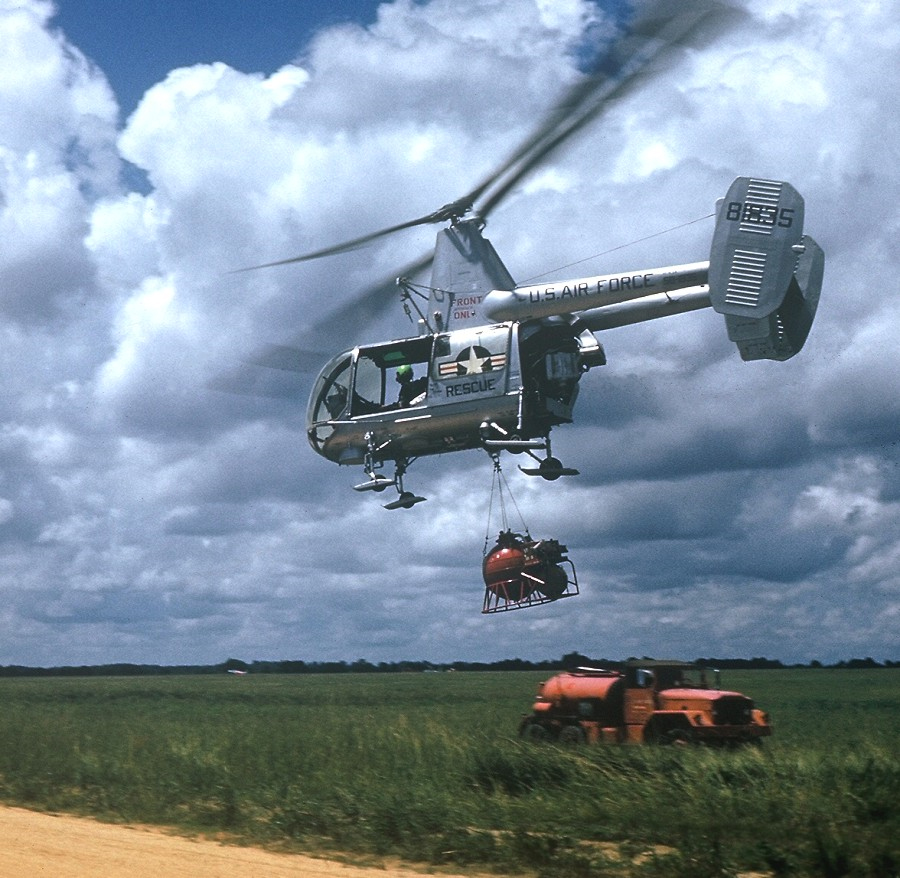
58-1835 3615th PTW , Craig AFB, AL August 1959 (photo by C.Damonte)
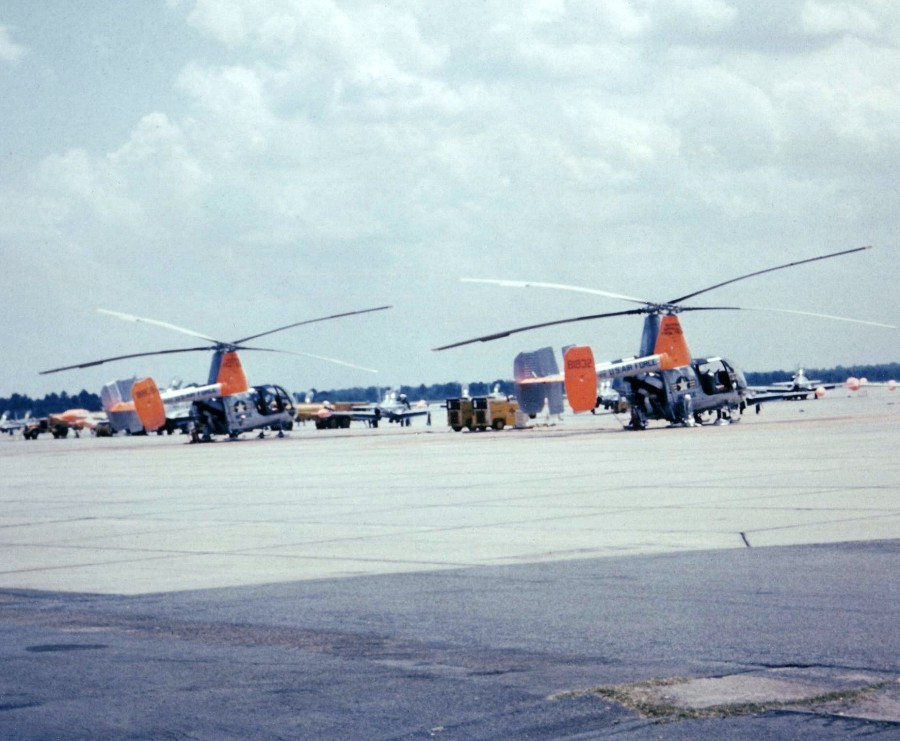
58-1832 and 58-1835 3615th PTW , Craig AFB, AL ca1960 (photo C.Damonte)
3.5.2 Personal account by Bill Malpass – dated 13 nov 2002 ( unknown guestbook entry)
I was stationed at Craig AFB from Aug 1959 to April 1961 We at that time had H-43A’s. There were two of them and you can clearly see the tail numbers on them. I was a firefighter assigned to them at that time.
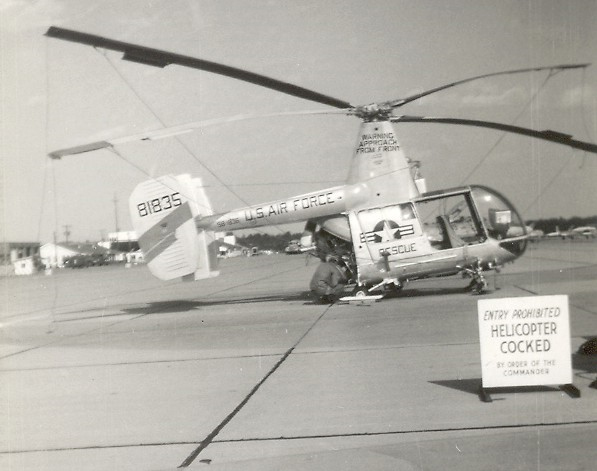
58-1835 3615th PTW , Craig AFB, AL June 1960 (photo B.Malpass)
3.5.3 Known crewmembers who have been assigned to this H-43A unit.
Collegues of, then 2/Lt. Damonte, were pilots Capt. Robert (Bob) Glore, Officer In Charge, 1/Lt. Jack Warden, and 1/Lt. William (Bill) Hoerman.
3.5.4 “1000-Hour Pilot Awards”
HONORED BY KAC Latest pilots to receive desk set awards from Kaman Aircraft for logging 1000 hours in helicopters produced by the company are:
Capt C. R. Damonte, Det 11, EARC, Craig AFB, Ala.
(Source : Kaman RotorTips , issue Jun-July64 , page 9 )
3.5.5 Retirement H-43A
H-43A 58-1832 and 58-1835 both arrived at the boneyard, Davis-Monthan AFB, AZ durind Dec 1961.
3.5.6 New Aircraft
One HH-43B aircraft, 59-1586, was flown by 1/Lt Carlton Damonte from Brookley AFB, AL to Craig AFB on 28 Oct 1961. The other HH-43B, 59-1591, was flown by pilot Damonte from Pope AFB, NC to Craig AFB on 09 Nov 1961.
3.6 Randolph AFB, TX – 3510th PTW – DET.28, CARC
H-43A 58-1833 and 58-1834 were both accepted on 13 May 1959
3.6.1 KC-97G crashed near Randolph AFB 04 Nov 1960
(Source : “A chronological listing of rescue reports as received from the field by the Kaman Aircraft Corporation”)
An Air Force H-43A rescue helicopter and its crew have been credited with saving the lives of 11 crew-members of a Strategic Air Command aerial tanker which made a crash landing near Randolph AFB, TX on 04 November 1960.
Quick action by the helicopter and its rescue crew prevented a serious explosion and fire when the big KC-97G tanker crash-landed in a field after three of its four engines quit five miles from Randolph.
The tanker was on its way from Davis Monthan AFB, AZ to its home base at Plattsburgh, New York, when, near Randolph Field, it developed trouble in three engines in rapid succession. To add to the problem, the third engine caught fire.
After declaring an emergency, the pilot of the KC-97G headed for Randolph but was unable to make it. The H-43A crash-rescue helicopter, which took off on first word from the crippled aircraft, followed the tanker in its landing procedure.
Almost as the big craft slid to a stop in a plowed field, the H-43A landed a fire suppression kit which it had been carrying on its cargo hook and its fire fighting crew. The crew had put out the engine fire before it could ignite 4,000 gallons of high octane aviation gasoline. Approximately a minute’s time has elapsed from the time the plane crashed and the ‘copter touched down.
The helicopter then flew Members of the tanker crew, two of whom were injured, to the base hospital. It returned to the scene to pickup five more crewmen and returned them to the base. Only when the helicopter returned to the crash site the third time had ground vehicles reached the scene.
Base officials credited the pilot’s skill in handling the helicopter’s rotor down-wash, and the quick availability of fire fighting equipment and crew at the scene, with the prevention of the loss of 11 lives and a valuable aircraft.
The helicopter was flown by Capt. Charles R. Pinson. The rescue crew members were SSgt. Donald L. Baker (FF) and A1C Robert C. Birch (FF).
(from AF Accident Report : KC-97G serial number 52-2740, assigned to 380 BW, crash-landed 7 miles west northwest of Randolph AFB, at 1635Z)
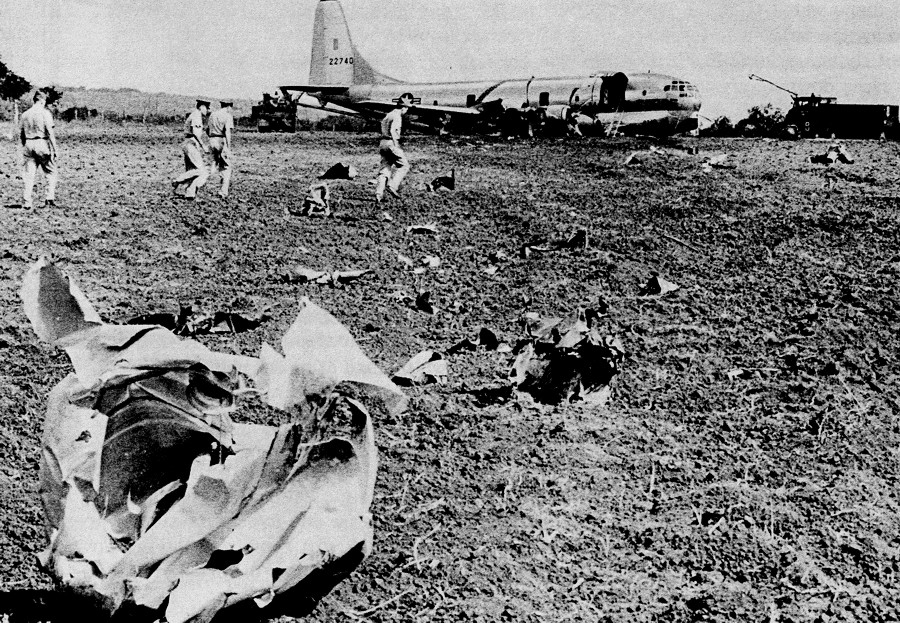
Kaman RotorTips , Dec 1960 , page 7
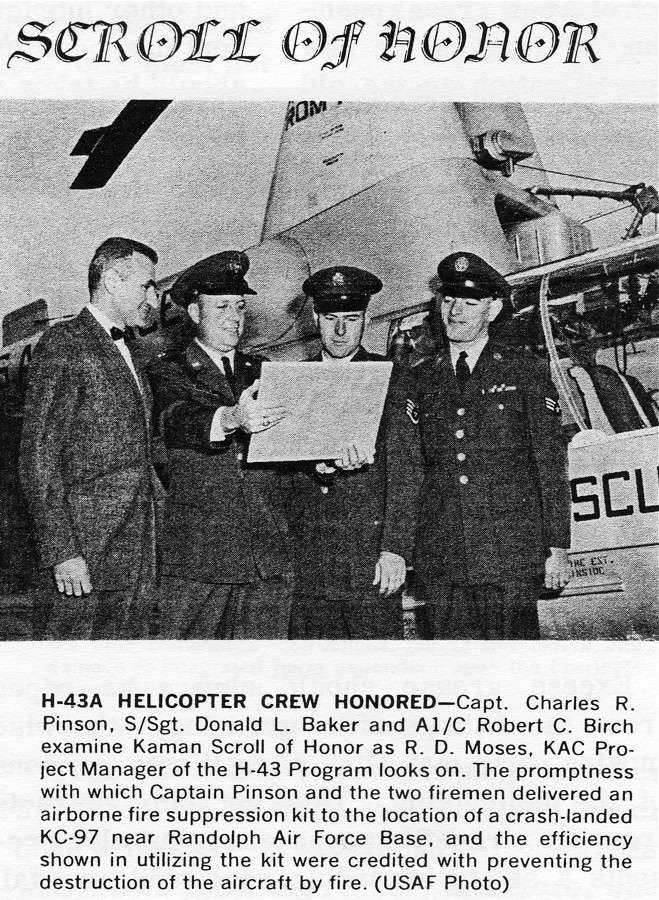
Scroll of Honor , Kaman Rotor Tips , March 1961 , page 6
3.6.2 “1000-Hour Pilot Awards”
HONORED BY KAC Latest pilots to receive desk set awards from Kaman Aircraft for logging 1000 hours in helicopters produced by the company are:
Captain Burke, Det 12 (Randolph AFB) commander, logs his 1000th hour.
He flew 630 hours in HH-43A’s and 370 in the HH-43B
(source : Kaman RotorTips , issue Jun-July64 , page 9 )
3.6.3 Retirement H-43A
H-43A 58-1833 and 58-1834 both ferried to Eglin AFB, FL , assigned to PGCCE for tests. Arrived on 04 and 16 Jan 1963. 58-1834 was destroyed on 02 Feb 1963 and -1833 remained in storage there. Much later on display.
3.6.4 New Aircraft
Two H-43B aircraft were delivered to DET.28, CARC : 60-0284 and 62-4508. Both delivery dates are unknown , but took place during 1963.
3.7 Greenville AFB, MS – 3505th PTW – no assignment after 1960
Three H-43A aircraft were accepted at the Kaman, Bloomfield, CT facility : 58-1836 on 10 Jun 1959 , 58-1837 on 15 Jun 1959, and 58-1839 on 02 Jul 1959.
3.7.1 Darrel Couch (F-100 pilot) (source : Email 16 March 2013)
The H-43A slides were taken at a weekend upper class survival training. The pictures are of us in class 60-H at Greenville, MS., being trained in how to use the one man life raft in the ejection seat survival kit and the proper way to use a helicopter lift sling. The location is between the Mississippi River and the flood control levy on the east side of the Mississippi River about a mile north of the US Highway 82 river bridge to Arkansas.
We would go out on Friday afternoon and return on Sunday afternoon. For supplies, we were given some parachute cloth for a tent, sleeping bags, a gallon bucket, some aluminum foil and about enough food
for one meal. That food was to supplement any food you found to eat for that afternoon and the next 2 days This was May 1960 and yes, there were plenty of mosquitoes and a few ticks.
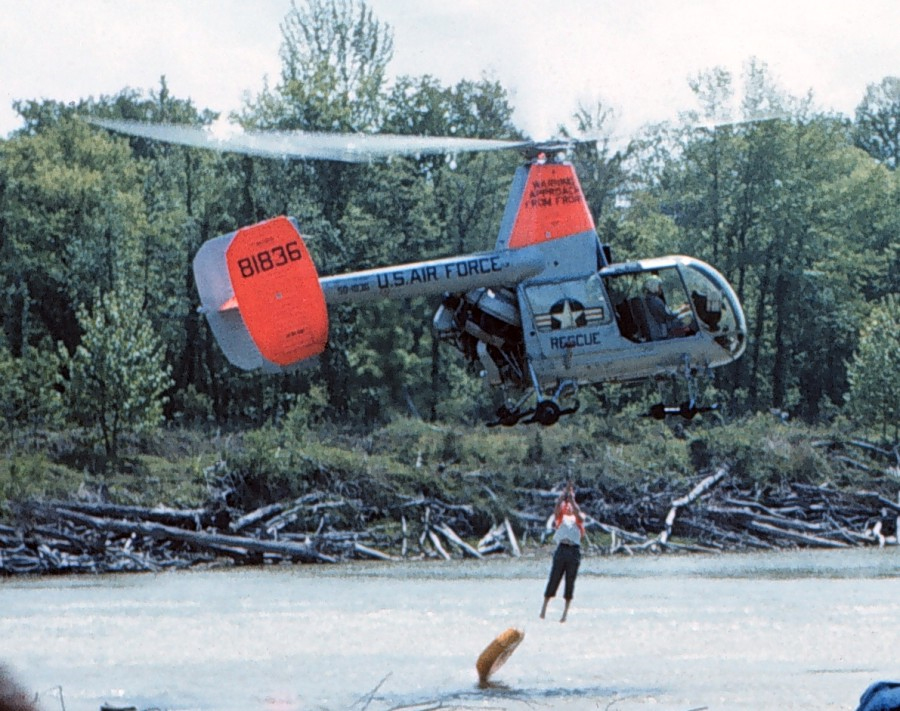
58-1836 3505th PTW , Greenville AFB, MS (photo D.Couch)
3.7.2 Known crewmembers who have been assigned to this H-43A unit
TSgt Joseph W. Blaquiere and SSgt Forrest G. Holt
3.7.3 Retirement H-43A (from Greenville AFB, MS)
H-43A 58-1837 was re-assigned to Perrin AFB, TX on 27 Jan 1960. Both 58-1836 and 58-1839 were re-assigned to Williams AFB, AZ on 28 Oct 1960.
3.8 Vance AFB, OK – 3575th PTW – DET.29, CARC
H-43A 58-1840 was accepted on 12 Aug 1959 and 58-1823 on 22 Sep 1959.
Pilot Harold Hering ferried one of the two H-43A from Bloomfield, CT to Vance AFB, OK.
3.8.1 Known crewmembers who have been assigned to this H-43A unit
3..8.1.1 Capt Harold L. Hering of Det 29, CARC, Vance AFB, Okla. ; reached the “magic” 1,000-hour mark in the HH-43B on 28 Feb 1963. A total of 630 hours were logged by Captain Hering in the HH-43A and 370 hours in the HH-43B. (source : Kaman RotorTips, issue June-July 1963 , page 17 )
3.8.1.2 Capt James E. Lamoreaux logged 480 hours in the H-43A.
3.8.2 Retirement H-43A
Both H-43A 58-1823 and 58-1840 were delivered to MASDC, Davis-Monthan AFB, AZ by Dec 1961.
3.8.3 New Aircraft
Two H-43B aircraft were delivered to DET.29, CARC from assignment at Forbes AFB, KS on 01 Oct 1961 : 60-0264 and 60-0265
3.9 Williams AFB, AZ – 3525th PTW – DET.16, WARC
H-43A 58-1836 and 58-1839 were both delivered from Greenville, MS on 28 Oct 1960.
3.9.1 “Old Friends”
Capt Clifford E. Brandon of Det 16, WARC, Williams AFB, Ariz., recently (ca. mid 1964) logged his 1000th-hour in Kaman helicopters. He also has a unique relationship with one of the aircraft manufactured by the company.
On 02 July, 1959, Captain Brandon accepted H-43A 58-1839 at the Kaman facility in Bloomfield, CT, and flew it to Greenville AFB, MS. In October of 1960 the entire unit was transferred to Williams AFB and the captain flew -839 to her new home. Then, on 12 Jan 1962, Captain Brandon filed the final flight clearance on Air Force helicopter 58-1839 and flew it to Davis-Monthan AFB for storage (12 Jan 1962). During her Air Force career 58-1839 flew 271 rescue missions.
(source : Kaman RotorTips issue Oct-Nov64-page 14)
3.9.2 Known crewmembers who have been assigned to this H-43A unit
3.9.2.1 Pilot Bill Wall
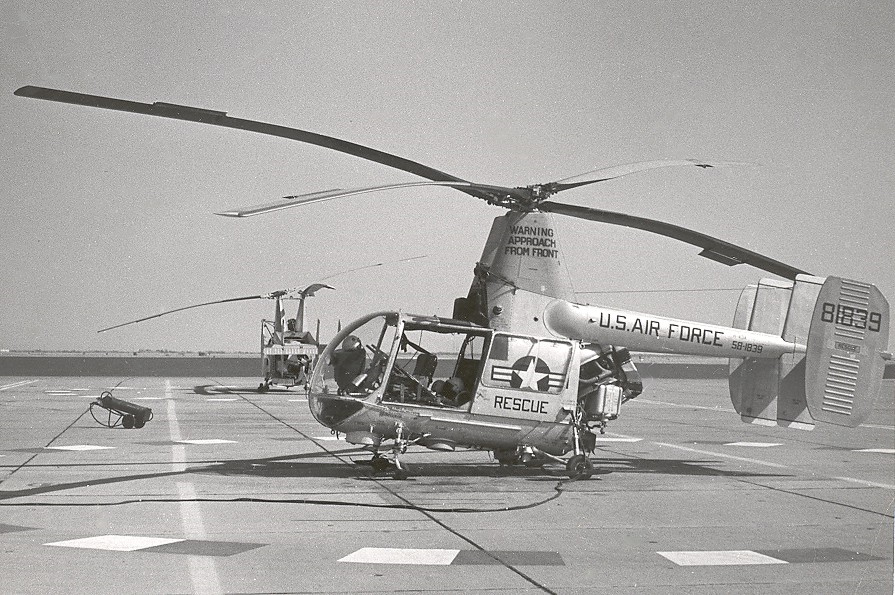
58-1839 Williams AFB, AZ late 1961 , photo by Bill Wall
3.9.3 Retirement H-43A
Both H-43A 58-1836 and 58-1839 were delivered to MASDC, Davis-Monthan AFB, AZ during Jan 1962
3.9.4 New Aircraft
Two H-43B aircraft were delivered from Offutt AFB, NB on 01 Oct 1961 : 59-1582 and 59-1583
3.10 Known crewmembers who have been assigned to unknown H-43A units
3.10.1 Capt D.W. Thomas logged 391 hours in the H-43A
(source : Kaman RotorTips , issue Apr 1963 , page 14 )
3.10.2 “1000-Hour Pilot Award” – (photo) Capt Price S. Summerhill, commander of Det 8, CARC, Selfridge AFB, Mich., is greeted by Capt Anthony G. Volonis after logging 1000th hour in a Kaman helicopter. In an other photo, Captain Summerhill congratulates Capt Ernest L. Neville, also of Det 8, upon reaching the same milestone. Both HH-43B pilots, who also flew in HH-43A’s, will receive the award given by KAC in recognition of this achievement.
(source : Kaman RotorTips issue Oct-Nov64-page 14)
3.10.3 “1000-Hour Pilot Awards”
Thousand-hour plaque have been presented by the company to Capt Henry P. Fogg, Det 7, EARRC, Seymour Johnson AFB, NC.
Captain Fogg, who passed the magic mark while on duty in Southeast Asia, flew his time in HH-43A and HH-43B helicopters. (source : Kaman RotorTips, issue Nov-Dec67 , page 15)
3.10.4 Milestoners
During the month of March 1970, two HH-43 pilots attached to Det 8, 41st ARRWg, passed important milestones in their flying careers. Maj Welton C. Ritchie, Jr., logged his 2,000th hour of HH-43A and B time (source : Kaman RotorTips, issue May-Jun-Jul-1970 , – page 10 )
4.0 FROM the “A” model to the H-43B “Huskie”
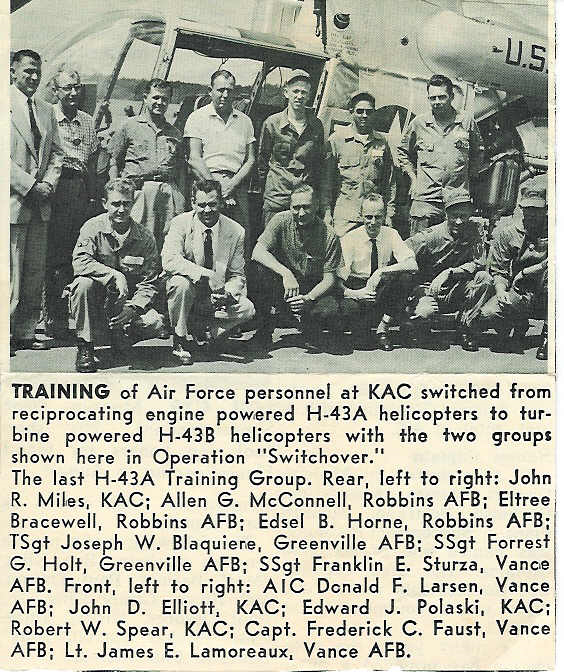
date : 20 Aug 1959 credit : D. Larson , via. Steve Mock
TRAINING of Air Force personnel at KAC switched from reciprocating engine powered H-43A helicopters to turbine powered H-43B helicopters with the two groups shown here in Operation “Switchover”.
The last H-43A Training Group. Rear, left to right :
John R. Miles , KAC ; Allen G. McConnell, Robins AFB, GA ; Eltree Bracewell, Robins AFB, GA ; Edsel B. Horne, Robins AFB, GA ; TSgt Joseph W. Blaquiere, Greenville AFB, MS ; SSgt Forrest G. Holt, Greenville AFB, MS ; SSgt Franklin E. Sturza, Vance AFB, OK ;
Front, left to right :
A1C Donald F. Larsen, Vance AFB, OK ; John D. Elliott, KAC ; Edward J. Polaski, KAC ; Robert W. Spear, KAC ; Capt. Frederick C. Faust, Vance AFB, OK ; Lt. James E. Lamoreaux, Vance AFB, OK.
5.0 Retirement of H-43A aircraft
Hq USAF had directed that the 17 (one crashed) H-43A aircraft gained by ARS upon assumption of the LBR program are to be placed in storage at Davis-Monthan AFB as they become excess to command requirements.
The airlift is being effected by WESTAF C-124 aircraft returning to home station from IRAN at Hayes Aircraft Corporation, Birmingham, AL. Airlift was requested by this command as a means of preserving the LBR capability at bases concerned by eliminating extended TDY of ferry crews from austerely manned detachments.
17 H-43A become excess to command requirements :
| from | del to MASDC | Comments | to FAA 15Jan63 | |
| 58-1823 | Vance AFB | Dec61 | N2843J | |
| 58-1824 | Laredo AFB | Dec61 | N2844J | |
| 58-1825 | Laredo AFB | Dec61 | to EglinAFB for test, destroyed 1Mar63 | |
| 58-1826 | Moody AFB | 20Feb62 | N2844J | |
| 58-1827 | Moody AFB | 20Feb62 | N2846J | |
| 58-1828 | Perrin AFB | 31Jul62 | N2847J | |
| 58-1829 | Perrin AFB | 31Jul62 | N2848J | |
| 58-1830 | James Connally AFB | 16May62 | N2849J | |
| 58-1831 | crashed 16 May59 at JamConnally AFB | |||
| 58-1832 | Craig AFB | Dec61 | N2850J | |
| 58-1833 | Randolph AFB | in storage at Eglin AFB ,later as display aircraft** | N2851J | |
| 58-1834 | Randolph AFB | to Eglin AFB, 16Jan63 for tests, destroyed 02Feb63 | ||
| 58-1835 | Craig AFB | Dec61 | N2852J | |
| 58-1836 | Williams AFB | Jan62 | N2853J | |
| 58-1837 | James Connally AFB | 17Jun62 | accident at MASDC 23Oct62 ; to N612 | |
| 58-1838 | James Connally AFB | 16May62 | N2854J | |
| 58-1839 | Williams AFB | 12Jan62 | N2855J | |
| 58-1840 | Vance AFB | Dec61 | N2856J |
** The N2851J registration was never applied. After storage at Eglin AFB, FL HH-43A 58-1833 was transferred to Wright-Patterson AFB, OH (on an unknown date). It became part of the US Air Force Orientation Group (AFOG) , which performs ground-displays of aircraft on a mobile basis (source : BARG magazine).
At least as of August 1966, 58-1833 became a permanent display aircraft at the Florence Air & Space Museum grounds, Florence, SC.
After restoration during 1985/86 it became part of the Museum of Aviation, Robins AFB, GA. At first on outside display, as of 1994 on display inside the Museum.
In Oct 2013 aircraft 58-1833 was flown to McChord AFB, WA inside a C-17A. For display in the McChord Air Museum after restoration (by late 2018 still in storage here).
6.0 CIVIL REGISTERED H-43A
Thirteen HH-43A were bought by Rosenbalm Aviation, Inc. , Central Point, Medford, OR in February 1966. They were all in non-flyable condition, but by May 1966 N2853J was reworked and flying in it’s new role, forest firefighting.
In the table in the previous chapter all FAA registration numbers are given. Only eight aircraft from this group were in the end restored to flying condition : N2843J, 47J, 48J, 49J, 53J, 54J, 55J and 56J.
All, except N2849J and N2856J, were lost in accidents between 1970-1972.
N2856J survived and finally became owned by the Classic Rotors Museum, Ramona, CA in December 2005. They planned to restore the aircraft to flying condition with a first flight planned for 2009, but that has never happened because of a tragic accident with a HUP-1 helicopter which occurred in Nov 2009.
After his Air Force career, Mr. Bill Wall again became current on the HH-43A , the HOK as well as the HUK, then owned by Command Helicopters Inc., Medford, OR. During the period 1969-1972 he flew many hours in these helicopters. Forest firefighting and forest fertilizing in Washington State and Oregon were tasks undertaken with these helicopters.
Mr. Wall first flew the H-43A while assigned to DET.16, WARC at Williams AFB, AZ.
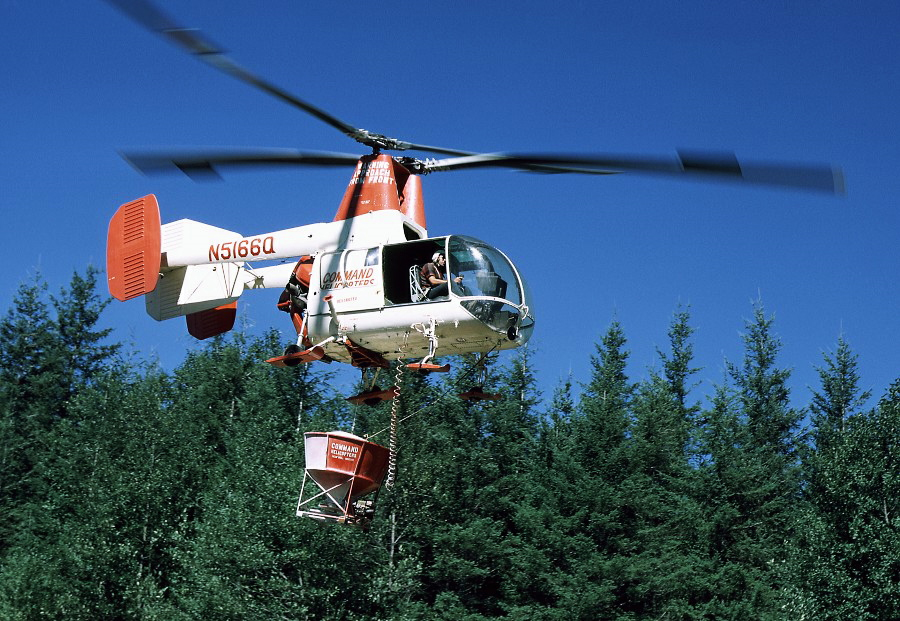
Bill Wall flying former HOK 129813 – N5166Q with fertilizer pod, Sep 1970
photo taken by former HH-43B pilot Jerry VanGrunsven
7. Book with detailed histories for all civil operated Kaman HOK, HUK, HH-43A, HH-43B/F and their operators was written by Johan Ragay, published in 2009.

